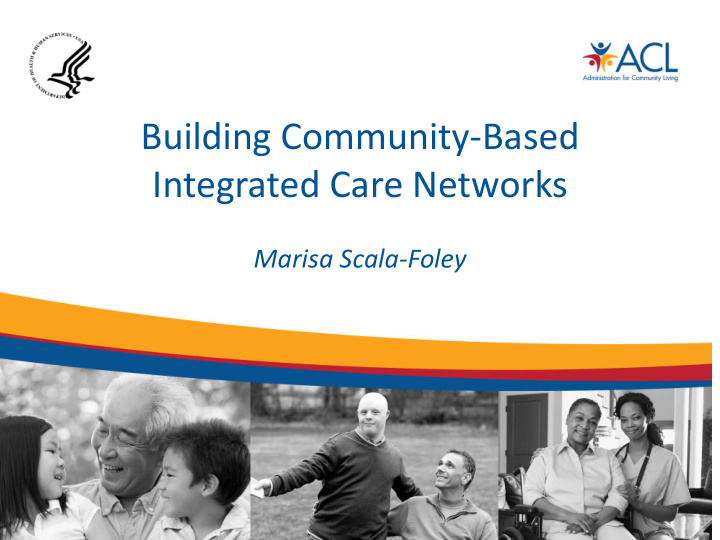



Building Community-Based Integrated Care Networks Marisa Scala-Foley
Where we started 2
Accountable Care Organizations ACOs) Community- Based Care Health Homes Transitions Program (CCTP) Integrated Care Opportunities Medicaid Duals Financial Managed LTSS Alignment (MLTSS) Initiative State Innovation Models (SIM) 3
Key Questions 4
For us…Where do we fit in? • Chronic disease self-management • Diabetes self-management • Nutrition programs (counseling & meal provision) Managing chronic • Education about Medicare preventive benefits conditions ACL • Evidence-based care • Evidence-based care transitions transitions • Care coordination Activating • Person-centered Preventing hospital • Information, referral & beneficiaries planning (re)admissions Community- • Chronic disease self- assistance/system State aging based aging & & disability management navigation disability agencies • Medical transportation • Information, referral & organizations • Evidence-based assistance/system medication reconciliation navigation • Benefits outreach and programs • Transitions from nursing • Evidence-based fall enrollment facility to home/community • Employment related prevention • Person-centered planning programs/home risk supports Diversion/ • Assessment/pre-admission • Community/beneficiary/ assessments Avoiding review • Nutrition programs caregiver engagement • Information, referral & long-term (counseling & meal assistance/system navigation residential provision) • Environmental modifications • Caregiver support stays • Caregiver support • Environmental • LTSS innovations modifications
For integrated care entities (especially health plans)… Build Buy it it 6
Where we are now 7
MLTSS Programs - 2015 NH VT ME WA ** MA MT ND MN OR ID NY WI ** RI MI SD CT WY PA RI NJ IA OH NE DE NV IN IL ** UT VA MD WV CA ** CO KS DC KY MO NC TN OK AZ AR SC NM GA AL MS LA TX FL AK Current MLTSS program (regional **) HI Duals demonstration program only MLTSS is being planned or implemented (2015 or later) Source: NASUAD 2014 State of the States; CMS
Concerns about sustainability & systems changes Source: Aging and Disability 2015 Information & Referral/Assistance National Survey, National Association of States United for Aging and Disabilities (NASUAD) in partnership with the National Council on Independent Living (NCIL) 9
ACL Business Acumen Learning Collaboratives • 2013-14: 9 CBO networks, 15 signed contracts, 1 MSO formed, 1 network LLC under formation, 1 organization accredited by NCQA for care management • 2015: 11 networks, 2 signed contracts (thus far), 2 under negotiation, 1 network LLC under formation 10
About the contracts • Most common services: Care transitions*, in-home assessment and medication reconciliation, care coordination & navigation, evidence-based programs (EBP) • Most common contracting organizations: duals plans*, Accountable Care Organizations, Medicaid MCO, physician group, state healthcare exchange 11
What we’ve learned • Culture matters • Relationships (and champions) are critical to the process • Contracts take TIME • What you want to sell may not be what they want to buy • Infrastructure to deal with “back office” functions (e.g., billing, tracking outcomes, information technology) is as important – if not more important – as pricing • Still many issues that need more work: Network service quality, performance measurement, information technology, accreditation, and more 12
What’s next? • New HHS delivery system reform goals: • Alternative Payment Models (e.g., ACOs, bundled payment arrangements): 30% of Medicare payments are tied to quality or value through alternative payment models by the end of 2016 50% by the end of 2018 • Linking FFS Payments to Quality/Value (e.g., Hospital Value Based Purchasing and the Hospital Readmissions Reduction Programs): 85% of all Medicare fee-for-service payments are tied to quality or value by 2016 90% by the end of 2018 • “Capture and spread” learnings from business acumen efforts to larger field of aging and disability organizations • Continue development of public-private partnerships 13
New opportunities (and challenges) • Increasing recognition of importance of social determinants of health Good for our networks…but also brings out competition • Getting the contracts may just be the easy part Dealing with conflict of interest, volume/scaling, IT, data access, performance measurement/management Opportunity to perform and to SHINE • Increasing number of champions: Foundations Health-care sector 14
One final thought “For these individuals [with both chronic conditions and functional limitations requiring long-term services and supports] to achieve better health, providers must be able to connect their patients to social supports and human services while focusing on prevention and wellness in ways that emphasize behavior change. By partnering with community-based organizations (CBOs), such as Area Agencies on Aging (AAAs), providers can help individuals manage their chronic diseases and meet their often overlooked social needs .” Dr. Anand Parekh & Dr. Robert Schneider “How Community-Based Organizations Can Support Value-Driven Health Care” Health Affairs, July 10, 2015 http://healthaffairs.org/blog/2015/07/10/how-community-based-organizations-can- support-value-driven-health-care/ 15
For more information: Marisa Scala-Foley Marisa.scala-foley@acl.hhs.gov 202-357-3516 http://acl.gov/Programs/CIP/OICI/BusinessAcumen/index.aspx 16
Recommend
More recommend